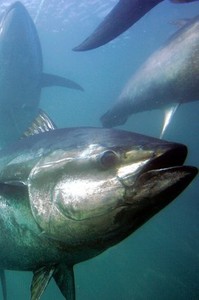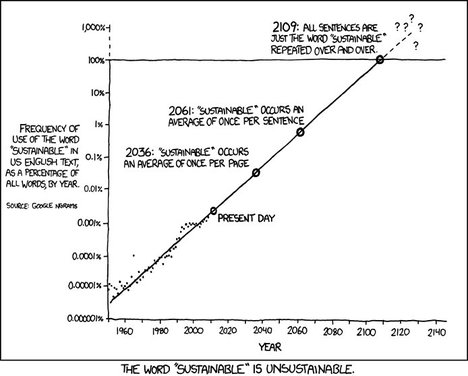 Source of cartoon: http://xkcd.com/1007/
Source of cartoon: http://xkcd.com/1007/
Category: Energy/Environment
Small Is Beautiful as Life Adapts to Global Warming
 “Artist’s reconstruction of Sifrhippus sandrae (right) touching noses with a modern Morgan horse (left) that stands about 5 feet high at the shoulders and weighs approximately 1000 lbs.” Source of caption and photo: online version of the NYT article quoted and cited below.
“Artist’s reconstruction of Sifrhippus sandrae (right) touching noses with a modern Morgan horse (left) that stands about 5 feet high at the shoulders and weighs approximately 1000 lbs.” Source of caption and photo: online version of the NYT article quoted and cited below.
(p. D3) The horse (siff-RIP-us, if you have to say the name out loud) lived in what is still horse country, in the Bighorn Basin of Wyoming, where wild mustangs roam.
. . .
Its preserved fossils, abundant in the Bighorn Basin, provide an excellent record of its size change over a 175,000-year warm period in the Earth’s history known as the Paleocene-Eocene thermal maximum, when temperatures are estimated to have risen by 9 to 18 degrees Fahrenheit at the start, and dropped again at the end.
Scientists have known that many mammals appear to have shrunk during the warming period, and the phenomenon fits well with what is known as Bergmann’s rule, which says, roughly, that mammals of a given genus or species are smaller in hotter climates.
Although the rule refers to differences in location, it seemed also to apply to changes over time. But fine enough detail was lacking until now.
In Science, Ross Secord, of the University of Nebraska-Lincoln; Jonathan Bloch, of the Florida Museum of Natural History at the University of Florida in Gainesville; and a team of other researchers report on the collection and analysis of Sifrhippus fossils from the Bighorn Basin.
They report that the little horse got 30 percent smaller over the first 130,000 years, and then — as always seems to happen with weight loss — shot back up and got 75 percent bigger over the next 45,000 years.
. . .
“It seems to be natural selection,” said Dr. Secord. He said animals evolved to be smaller during warming because smaller animals did better in that environment, perhaps because the smaller an animal is, the easier it is to shed excess heat.
For the full story, see:
JAMES GORMAN. “As the Planet Heated Up, First Horse Got Tinier .” The New York Times (Tues., February 28, 2012): D3.
(Note: ellipses added.)
(Note: the online version of the story is dated February 23 [sic], 2012 and has the title “A Tiny Horse That Got Even Tinier as the Planet Heated Up.”)
Majority of Marine Creatures Thrive in Greater Acidity
(p. C4) The effect of acidification, according to J.E.N. Veron, an Australian coral scientist, will be “nothing less than catastrophic…. What were once thriving coral gardens that supported the greatest biodiversity of the marine realm will become red-black bacterial slime, and they will stay that way.”
This is a common view. The Natural Resources Defense Council has called ocean acidification “the scariest environmental problem you’ve never heard of.” Sigourney Weaver, who narrated a film about the issue, said that “the scientists are freaked out.” The head of the National Oceanic and Atmospheric Administration calls it global warming’s “equally evil twin.”
. . .
If the average pH of the ocean drops to 7.8 from 8.1 by 2100 as predicted, it will still be well above seven, the neutral point where alkalinity becomes acidity.
. . .
In a recent experiment in the Mediterranean, reported in Nature Climate Change, corals and mollusks were transplanted to lower pH sites, where they proved “able to calcify and grow at even faster than normal rates when exposed to the high [carbon-dioxide] levels projected for the next 300 years.” In any case, freshwater mussels thrive in Scottish rivers, where the pH is as low as five.
Laboratory experiments find that more marine creatures thrive than suffer when carbon dioxide lowers the pH level to 7.8. This is because the carbon dioxide dissolves mainly as bicarbonate, which many calcifiers use as raw material for carbonate.
For the full commentary, see:
MATT RIDLEY. “MIND & MATTER; Taking Fears of Acid Oceans With a Grain of Salt.” The Wall Street Journal (Sat., January 7, 2012): C4.
(Note: ellipsis in first paragraph in original; ellipses between paragraphs added.)
Few Jobs from Billions Feds Spent on Green Stimulus
 “County Commissioner Rosaura Tijerina supported tax breaks for the Cedro Hill wind farm, but it brought few new jobs.” Source of caption and photo: online version of the WSJ review quoted and cited below.
“County Commissioner Rosaura Tijerina supported tax breaks for the Cedro Hill wind farm, but it brought few new jobs.” Source of caption and photo: online version of the WSJ review quoted and cited below.
(p. A1) Alfredo Garcia was among the residents of Webb County, Texas, banking on a windfall from federal stimulus money.
Mr. Garcia expanded his Mexican restaurant from 80 to 120 seats, anticipating a rush of new patrons springing from the nearby Cedro Hill wind farm, a project built with the help of $108 million from U.S. taxpayers.
When construction ended, Cedro Hill had just three employees and Mr. Garcia’s restaurant, Aimee’s, filed for bankruptcy protection. “Nobody came,” said Mr. Garcia, a county judge who closed Aimee’s last year, putting 18 people out of work.
Companies have received more than $10 billion to create jobs and renewable energy by building wind farms, solar projects and other alternatives to oil and natural gas under section 1603 of the American Recovery and Reinvestment Act of 2009. The program expired in December, and President Barack Obama proposed last week that Congress revive it in the 2013 budget.
On federal applications, companies said they created more than 100,000 direct jobs at 1603-funded projects. But a Wall Street Journal investigation found evidence of far fewer. Some plants laid off workers. Others closed.
The discrepancies highlight broader challenges calculating the economic benefits of stimulus spending. Jobs have been an important measure influencing distribution of more than $800 billion in stimulus money, which also has included tax breaks and spending on roads, sewers, schools, health and public assis-(p. A10)tance. Yet the number of jobs created or saved is largely based on formulas, mathematical models and reports by recipients, rather than actual tallies.
For the full story, see:
IANTHE JEANNE DUGAN and JUSTIN SCHECK. “Cost of $10 Billion Stimulus Easier to Tally Than New Jobs.” The Wall Street Journal (Fri., FEBRUARY 24, 2012): A1 & A10.
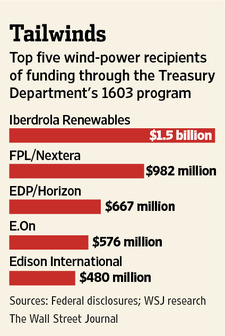
Source of graphic: online version of the WSJ story quoted and cited above.
Manifesto for a Rising Standard of Living
Source of book image: online version of the WSJ review quoted and cited below.
(p. A13) Mr. Diamandis is the chairman and chief executive of the X Prize Foundation and the founder of more than a dozen high-tech companies. With his journalist co-author, he has produced a manifesto for the future that is grounded in practical solutions addressing the world’s most pressing concerns: overpopulation, food, water, energy, education, health care and freedom. The authors suggest that “humanity is now entering a period of radical transformation where technology has the potential to significantly raise the basic standard of living for every man, woman, and child on the planet.”
. . .
Predictions of a rosy future have a way of sounding as unrealistic as end-is-nigh forecasts. But Messrs. Diamandis and Kotler are not just dreamers. They lay out a plausible road map, discussing, among other things, the benefits of do-it-yourself tinkering–like the work by geneticist J. Craig Venter in beating the U.S. government in the race to sequence the human genome–and the growing willingness of techno-philanthropists like Bill Gates to tackle real-world problems.
The biggest hurdles, however, are not scientific or technological but political. There are still too many corrupt dictators and backward-looking governments keeping millions in penury. But as we have seen lately, the misruled have a way of throwing off despotic governments. With ever more people reaching for freedom, countless millions are tacitly embracing the Diamandis motto: “The best way to predict the future is to create it yourself.”
For the full review, see:
MICHAEL SHERMER. “BOOKSHELF; Defying the Doomsayers; Abundance” argues that growing technologies have the potential not only to spread information but to solve some of humanity’s most vexing problems.” The Wall Street Journal (Thurs., FEBRUARY 22, 2012): A13.
(Note: ellipsis added.)
The book being reviewed is:
Diamandis, Peter H., and Steven Kotler. Abundance: The Future Is Better Than You Think. New York: Free Press, 2012.
BP Oil Spill Does Little Harm to Tuna
“The Gulf of Mexico’s bluefin-tuna population is likely to be cut by less than 4% because of the BP oil spill.” Source of caption and photo: online version of the WSJ article quoted and cited below.
(p. A6) Fears that last year’s BP PLC oil spill would decimate the bluefin tuna that spawn in the Gulf of Mexico haven’t played out, with the population of the prized fish likely to be cut by less than 4%, a federal study has concluded.
The oil from the biggest offshore spill in U.S. history covered about one-fifth of the habitat of the Gulf’s recently hatched tuna, and scientists feared that could hammer the future population of the fish.
An analysis based on two different models by the National Oceanic and Atmospheric Administration, or NOAA, has concluded that the spill “will likely result in less than a 4% reduction in future spawning biomass” of bluefin tuna in the Gulf.
. . .
Russell Miget, an environmental and seafood quality specialist with Texas A&M University who wasn’t associated with the research, said the tuna study squared with other data suggesting that the impact of the spill on marine life was “less than what people were concerned about at the time of the spill.” Still, “fishery science is not an exact science,” he said.
For the full story, see:
GAUTAM NAIK and NATHAN KOPPEL. “Bluefin Tuna Thrive Despite Oil Spill.” The Wall Street Journal (Tues., December 6, 2011): A6.
(Note: ellipsis added.)
(Note: the online version of the article had the title “Bluefin Tuna Endure After Oil Spill.”)
Federal Subsidies Create Few Green Jobs
(p. F2) . . . solar power, which makes extensive use of robots in fabricating the cells, and has no moving parts to service once it is up and running, may be an odd choice for job creation.
“It’s just not that labor-intensive,” said Howard Axelrod, an engineer and economist. And as for the jobs it creates, there may be a price elsewhere, Dr. Axelrod said.
. . .
Build enough solar plants and some coal plants will shut down; that would amount to firing Peter to hire Paul.
. . .
And, economists point out, some of the work that renewable energy creates goes to people who already have jobs — roofers who install the panels or truck drivers who move them around, or steel workers who make towers for new wind machines.
Some of the jobs could eventually go elsewhere. Two years ago, Evergreen Solar, which got $58 million in aid from Massachusetts for a factory in Devens, said it would shift production to China instead.
. . .
The debate is part of a larger discussion of what constitutes a “green” job. In October 2009, Congress gave the Bureau of Labor Statistics a special appropriation to count them.
. . .
“Driving a bus is driving a bus, right?” said Connie Mack, Republican of Florida. Hilda Solis, the secretary of labor, said they were “green buses.” But aides later clarified that the bureau counted any bus driving job as green because it preserved natural resources.
None of this suggests that green is bad, just that it is not particularly job-heavy. In December 2010, Susan Combs, the comptroller of Texas, reported that school districts in her state were giving tax abatements to lure new jobs, but had to give $1.6 million for every wind energy job. Manufacturing jobs could be created for $166,000 each.
For the full story, see:
MATTHEW L. WALD. “Solar Power Industry Falls Short of Hopes in Job Creation.” The New York Times (Weds., October 26, 2011): F2.
(Note: ellipses added.)
(Note: the online version of the article has the date October 25, 2011.)
Science Not Accurate at Predicting Storm Intensity
(p. D1) For scientists who specialize in hurricanes, Irene, which roared up the Eastern Seaboard over the weekend, has shone an uncomfortable light on their profession. They acknowledge that while they have become adept at gauging the track a hurricane will take, their predictions of a storm’s intensity leave much to be desired.
Officials with NOAA’s National Hurricane Center had accurately forecast that Irene would hit North Carolina, and then churn up the mid-Atlantic coast into New York. But they thought the storm would be more powerful, its winds increasing in intensity after it passed through the Bahamas on Thursday.
Instead, the storm lost strength. By the time it made landfall in North Carolina two days later, its winds were about 10 percent lighter than predicted.
It’s not a new problem. “With intensity, we just haven’t moved off square zero,” Dr. Marks said. Forecasting a storm’s strength requires knowing the fine details of its structure — the internal organization and movement that can affect whether it gains energy or loses it — and then plugging those details into an accurate computer model.
Scientists have struggled to do that. They often overestimate strength, which can lead to griping about overpreparedness, as it has with Irene. But they have sometimes underestimated a storm’s power, too, as with (p. D3) Hurricane Charley in 2004. And it is far worse to be underprepared for a major storm.
For the full story, see:
HENRY FOUNTAIN. “Intensity of Hurricanes Still Bedevils Scientists.” The New York Times (Tues., August 30, 2011): D1 & D3.
(Note: the online version of the article is dated August 29, 2011.)
Berkeley Environmentalist Sticks to Her Knitting
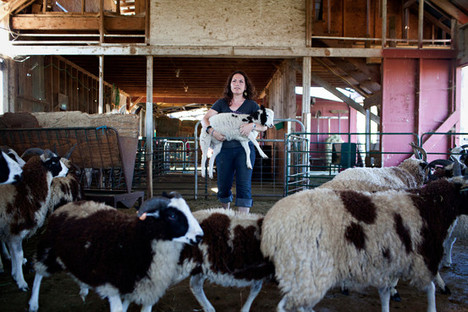 “Avid knitter Shelby Stofle, gathering wool from sheep in Vacaville Calif., hopes to set up a business making scarves and selling them at craft fairs.” Source of caption and photo: online version of the WSJ article quoted and cited below.
“Avid knitter Shelby Stofle, gathering wool from sheep in Vacaville Calif., hopes to set up a business making scarves and selling them at craft fairs.” Source of caption and photo: online version of the WSJ article quoted and cited below.
(p. A5) Shelby Stofle graduated in December from the University of California at Berkeley with $10,250 in student-loan debt–and no job offers from a dozen applications.
The 24-year-old had hoped to work in environmental conservation or sustainable agriculture but struck out even at a grocery store near her rural hometown of Suisun City, Calif.
. . .
With many employment options exhausted, she said she feels her best shot is to set up her own business, selling her hand-made scarves at craft fairs and farmers’ markets.
For the full story, see:
VAUHINI VARA. “As Jobs Vanish, Sticking to Knitting.” The Wall Street Journal (Mon., OCTOBER 31, 2011): A5.
(Note: ellipsis added.)
Power to the People
 Source of photo: online version of the NYT article quoted and cited below.
Source of photo: online version of the NYT article quoted and cited below.
In the Thursday, November 10, 2011 “Home” section of The New York Times, the lead article was about a surge in demand for personal electricity generators among the middle-class of the northeastern United States (places like Connecticut).
Perhaps the lesson is that “green” is a passing fad, but electric power is a necessity in preserving bedrock values such as light, warmth and communication?
(p. D1) WHEN the snowstorm hit a week ago Saturday, Evan Sidel was driving home from the supermarket, having stocked up on soup ingredients, thinking she and her two daughters would have a cozy evening in. But while she was unpacking the groceries, the power went out with an audible bang, said Ms. Sidel, who lives in a 100-year-old farmhouse in Wilton, Conn.
“You could literally hear the transformer exploding,” she said.
Then things went south fast, escalating perilously like the plot of an action movie, or “Spider-Man: Turn Off the Dark” in previews. As Ms. Sidel pulled an old land-line telephone out of the closet, one birch tree crashed into the side of her house and another into her front door.
“I called a friend who said, ‘My generator has just kicked in, come on over.’ I got out through the garage, drove over the lawn to the street, and I stayed at my friend’s house until Wednesday,” she recounted.
. . .
(p. D7) The back story to the recent biblical weather was the Great Generator Divide. With hundreds of thousands of households without power last week — nearly 800,000 in Connecticut alone — who had a generator (and how big it was) was the second most urgent topic in New Jersey, New York and Connecticut. Generator envy ran wide and deep as the staccato growl and smoky breath of portable generators defined the haves and the have-nots in many neighborhoods.
. . .
A few months ago, Mr. Petersheim offered to retrofit the houses he had built in Barryville, N.Y., with standby generators.
“We were seeing more and more power outages in that area,” he said. “And it’s not a super-high-priority area, so the power can stay out for days. Pipes can freeze, food spoils, you can’t get water. It’s become a stress point for our customers. I sent out an e-mail to 20 of them saying, ‘If you’re getting too annoyed with this, it’s pretty affordable, under $7,000 for a 14-kilowatt Generac fueled by propane.’ Seven took us up on it.”
Courtney and Bronson Bigelow (she’s in public relations, he’s a lawyer) were among them. “The first time we had a power outage, it was kind of romantic,” Ms. Bigelow said. “But then it kept happening. When you’re trying to squeeze every second of your weekend, it’s a huge bummer. You can’t wash dishes, you can’t wash yourself, and it’s 20 degrees. This summer we had this freakish weather, torrential rains over Fourth of July, then these weird microburst thunderstorms, and then Irene.”
. . .
Over in Lakeville, Conn., Allen Cockerline, who raises grass-fed cattle with his wife, Robin, at their Whippoorwill Farm, has two large portable generators, 10 and 15 kilowatts each. One runs off his tractor; the other is powered by gasoline. (The tractor-powered one he bought with the farm; the other one cost about $1,500, he said.)
They are a necessary insurance policy for a perishable product, he said: “There’s $30,000 worth of beef in my freezer. I’m not going to let that go.”
But armed as he is against calamity, Mr. Cockerline will admit to some generator envy.
“Everyone that surrounds me is on a much more turnkey situation,” he said. “Theirs just go on automatically. They don’t have to go out and move tractors and generators around.”
“My system is down-and-dirty,” he added, and “in that respect I have a certain amount of envy. But I’m sure my generators are bigger than theirs. Much bigger.”
For the full story, see:
PENELOPE GREEN. “Dark with Envy.” The New York Times (Thurs., November 10, 2011): D1 & D7.
(Note: ellipses added.)
(Note: the online version of the article is dated November 9, 2011 and had the title “Power Envy.”)
“Courtney and Bronson Bigelow and their Generac generator in Sullivan County, N.Y.” Source of caption and photo: online version of the NYT article quoted and cited above. 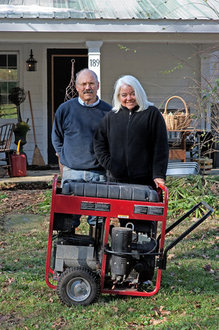
“Allen and Robin Cockerline with one of their two portable generators, in Lakeville, Conn.” Source of caption and photo: online version of the NYT article quoted and cited above.


